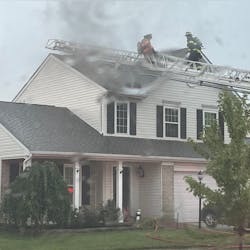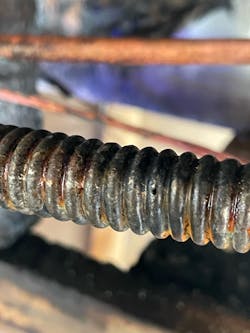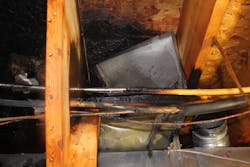Close Calls: Our Latest Enemy Strikes … Again
If you followed this column for the past year or so, you know that we shared an unrecognized problem for firefighters: corrugated stainless steel tubing (CSST) used as a gas transmission line in many dwellings that were constructed since the 1990s.
A recent lightning-induced arcing event caused a pinhole in CSST, which created a sustained gas flame in the space between the floor of the second floor and the ceiling of the first floor. The actions of a battalion chief doing a 360 and shutting off the gas stopped the gas-fed fire (not known to him yet as the cause), which produced a smoldering fire for the members to find and deal with.
Our thanks to Hamilton Township, OH, Fire Rescue (HTFR) Chief Jason Jewett and Assistant Chief Daniel Berkebile, HTFR’s officers and members, and the departments that provided automatic mutual aid and/or covered the district/other severe weather-related calls during the incident: City of Mason Fire Department (CMFD), Deerfield Township Fire Rescue (DTFR), Harlan Township Fire & Rescue, Lebanon Fire Division, Salem/Morrow Fire Department and Union Township Fire Department as well as Warren County Emergency Communications dispatchers.
Storms and heavy lightning
On July 27, 2023, HTFR Engine 77 (crew of three) and multiple mutual-aid partners responded to a reported structure fire that was caused by a lightning strike.
DTFR Ladder 57 (quint) arrived first due and reported nothing apparent from the exterior but an odor of smoke in the area. On entering the front door, the crew was met with heavy smoke conditions. Chief 76 arrived, assumed command and upgraded the assignment to a working fire. L57 secured its own water source and stretched a 1¾-inch attack line to the front door.
E77, the second-due company, laid a 5-inch supply and brought its own water, with one member left at the hydrant to assist with the connection. E77 was assigned to the Alpha division supervisor (DTFR Battalion 56) along with L57. E77 met up with L57 at the front door and confirmed with BA56 that the 360 size-up was complete. BA56 assigned L57 and E77 to the interior for search and fire control on the second floor.
Interior crews made the second floor and encountered high heat and blackout smoke conditions but no visible fire. Thus, crews assumed that the fire was in the attic space and began to pull the ceiling and flow water into the attic. Importantly, that wasn’t where the fire was.
As L57 continued to make its way down the hallway, E77 performed a primary search of the second floor and reported an all clear. E77’s officer provided command with a conditions/actions/needs report of heat conditions improving but smoke conditions unchanged and requested a crew to vent the roof. Once completed, there was smoke immediately from that vent hole.At this point, the members weren’t aware that they were dealing with a fire in the space between the floor of the second floor and the first floor ceiling. This isn’t uncommon with a lightning strike, affecting the CSST gas lines and increasing the risk of members going through the floor.
As the crews continued their search for the seat of the fire, a large hole in the hallway floor was discovered when a member of L57 put his hand through the floor. Interior crews communicated this to command and then advised that they were backing out to recycle.
Berkebile (Chief 77) was sent to Division 2 and had crews redirected to the first floor, including CMFD’s Engine 51, which went under the area that turned out to be the garage, opened up the ceiling and applied water using the second line that was stretched by E77. That’s when fire was found in the void space that was over the garage.
When Berkebile reached the top of the stairs, crews advised him that they were pulling ceiling to check for extension and to be careful, because there was a hole in the floor in the hallway.
“I asked if anyone had been to the first floor to check under us, because the floor was burned out. They hadn’t,” Berkebile tells Firehouse Magazine.
He assigned the crew that was on the stairs that were behind him to go to the first floor and pull ceiling to check for any fire that was burning below them.
Soon, Berkebile heard the crew advise the Alpha supervisor that they had fire in the floor joist and were applying water.
DTFR Deputy Chief Daniel James says that once L57’s crew entered the structure, members checked the first floor, including with thermal imagers, and had smoke but no visible fire. The crew proceeded to the second floor. Members were at the top of the steps when the hand of the firefighter who was on the nozzle pushed through the burned floor, but still no fire conditions.
“The L57 officer remained at the top of the step until they could get something over the hole to proceed down the hallway,” James says. Fire was in the master bedroom closet. The cold air return channel was there.
Berkebile had E51’s crew redirect to the first floor to check for extension. The crew first looked into the kitchen and found smoldering above the kitchen cabinets along the wall toward the garage. When they went to the garage, they began to hook the same area as the kitchen and found the fire that was caused by the gas line.
DTFR Engine 58 and E51 replaced working crews (who exited the structure) and completed primary searches of the first floor while locating fire in the floor joists of the second floor above the garage where initial crews worked. The fire was fully extinguished and then confirmed to be out.
Significant damage was sustained to the floor joists of the second floor and to the attic and roof. Crews remained on scene for a short time to perform overhaul and salvage operations before demobilizing.Comments from Jewett
When asked what went well, Jewett cited:
Communications/coordination. This was an intensely chaotic sequence of events because of numerous runs in extreme weather conditions within 15 minutes. All crews maintained a level of calm and made clear and concise communications that allowed units to divert from several low-priority runs to a high-priority run.
Accountability. Command was aware of which companies and personnel were operating in what locations at all times.
Fast water. Primary and secondary water were established very early in the incident. However, an evaluation of the need for a firefighter to be left at the hydrant versus operators handling it themselves is underway.
Discipline. Crews were disciplined and performed well, and communications were clear.
Apparatus operators working together. Operators of both L57 and E77 were proactive and worked synchronously together to ensure water and to ensure that ground ladders were thrown and other related operator tasks were performed.
Lessons learned/reinforced
Thermal imager always. It’s 2023. A thermal imager is an integral tool for any interior firefighter or crew. Like SCBA, radios and PPE, thermal imagers aren’t an option. E77’s officer didn’t have his thermal imager, which left only one for interior use.
Where is the fire? When you’re met with high heat and smoke conditions on the second floor and no visible fire, chances are good that the fire is below you. Given the damage to the floor joists in the short time that they burned, a floor collapse could have occurred with crews on the second floor.
Also, if conditions aren’t improving, tactics must change. That occurs when command and the fire officers communicate.
To vent or not to vent? Although certainly a tried-and-true tactic, generally, ventilation should be done in strict coordination/communication with applicable divisions and a decision affirmed by command once the fire is located and a line is stretched and operating.
Utilities. Being trained on and securing utilities when applicable is vitally important on any fireground. BA56 did this on his size-up. Conditions were kept from worsening by him simply stopping the gas flow.
Multiple runs. When numerous runs came because of the storms, the communications center continued to dispatch other runs, as per policy. HTFR will move toward “stacking” certain low-priority runs and managing them based on resources and time. Understand that when one district is hit with numerous storm-related runs, odds are that neighboring departments are as well.
Hydration. If you hydrate the day of your shift, you are behind the eight ball. Prehydrating the night before a shift is particularly important when heat index values are in the 100s. Avoid excessive caffeine and sugary drinks and eat smaller, lighter meals throughout the day.
Comments from Goldfeder
On a good day, without a fire, “new” lightweight wood construction is our enemy. We must know our enemy. CSST is part of that—like a weak artery within, but flowing gas. Since I learned about CSST and its relation to dwelling fires and two line-of-duty deaths, I was involved with two fires that involved CSST in my own regional backyard.
A single lightning strike can create multiple CSST arc holes and multiple flaming gas leaks within a structure at the same time. Alternatively, a lightning-
induced CSST arcing event can result in a sustained gas leak at the arc hole location without a flame, which creates a fuel-air explosion hazard. Both of these scenarios highlight the importance of isolating the gas utility early in the incident.
Now, consider this: You respond to a reported fire, lightning conditions occurred (or are ongoing) and the dwelling has smoke but no visible fire. Conduct your 360. Based on that, search as normal (always with a thermal imager, lines, tools, etc.). However, because of the fire that’s described above and the Maryland firefighters who gave their life, even more extreme caution is required—because a gas-fed fire in the void spaces (constructed of light wood that’s held together with glue and gusset plates) between the floors could bring you right down into the floor below.
Hamilton Township, OH, Fire Rescue
Hamilton Township is located in southwest Ohio and covers 35 square miles. It has an approximate population of 32,000 residents. They are protected by 40 personnel in two fire stations, with two engines, a quint and three ALS ambulances. The department answers 3,300 fire and EMS incidents annually.
About the Author
Billy Goldfeder
BILLY GOLDFEDER, EFO, who is a Firehouse contributing editor, has been a firefighter since 1973 and a chief officer since 1982. He is deputy fire chief of the Loveland-Symmes Fire Department in Ohio, which is an ISO Class 1, CPSE and CAAS-accredited department. Goldfeder has served on numerous NFPA and International Association of Fire Chiefs (IAFC) committees. He is on the board of directors of the IAFC Safety, Health and Survival Section and the National Fallen Firefighters Foundation.



